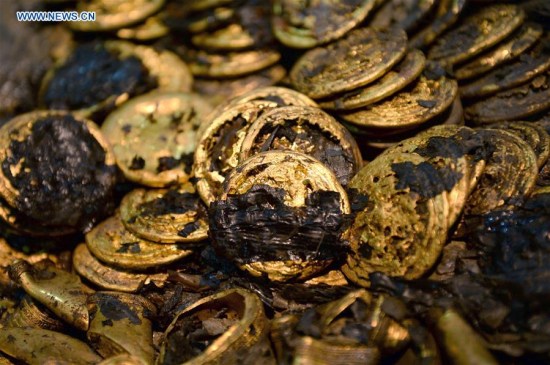
hoto taken on Dec. 24, 2015 shows gold cakes unearthed from the main coffin in the Haihunhou (Marquis of Haihun) cemetery, east China's Jiangxi Province. There were 96 gold cakes and several hoof-sahped golds newly unearthed between the inner and external coffin at the Haihunhou cemetery on Dec. 24, making the number of gold cakes unearthed here rise to 285, the most among all archaeological excavations of the Han Dynasty (206 B.C.-220 A.D.) tombs. (Photo: Xinhua/Wan Xiang)
The number of gold coins and plates unearthed from an east China ancient tomb has increased to 378, after archaeologists found another 68 on Friday.
The new finds include 20 thin plates about 22 centimeters long and 10 centimeters wide.
Archaeologists say it is the largest discovery of gold coins in any Han Dynasty tomb. The gold coins, most of which weigh about 250 grams, were unearthed from the tomb of the first "Haihunhou" (Marquis of Haihun) in Nanchang City, capital of east China's Jiangxi Province.
The sheer number of coins corroborates records that show China had significant gold reserve in that period. Records of the Western Han Dynasty speak of a general being rewarded with more than 50,000 kilograms of gold and a prince leaving 100,000 kilograms of gold when he died, Duan Qingbo, a professor with Northwest University said.
The tomb dates back to Western Han Dynasty (206 BC - 24 AD). It is thought to belong to Liu He, grandson of Emperor Wu. Liu was given the title "Haihunhou" after he was deposed as emperor after only 27 days. Haihun is the ancient name of a very small kingdom in the north of Jiangxi.
The main chamber of the tomb in the Haihunhou cemetery is still being searched. With a floor size of roughly 40,000 square meters with eight tombs and a burial site for chariot horses, it is the most complete Western Han Dynasty cemetery found to date.
The excavation began in 2011. Artifacts unearthed so far include a portrait of Confucius, nearly 3,000 wooden tablets and bamboo slips and a large number of bronze, gold and jade items.


















































